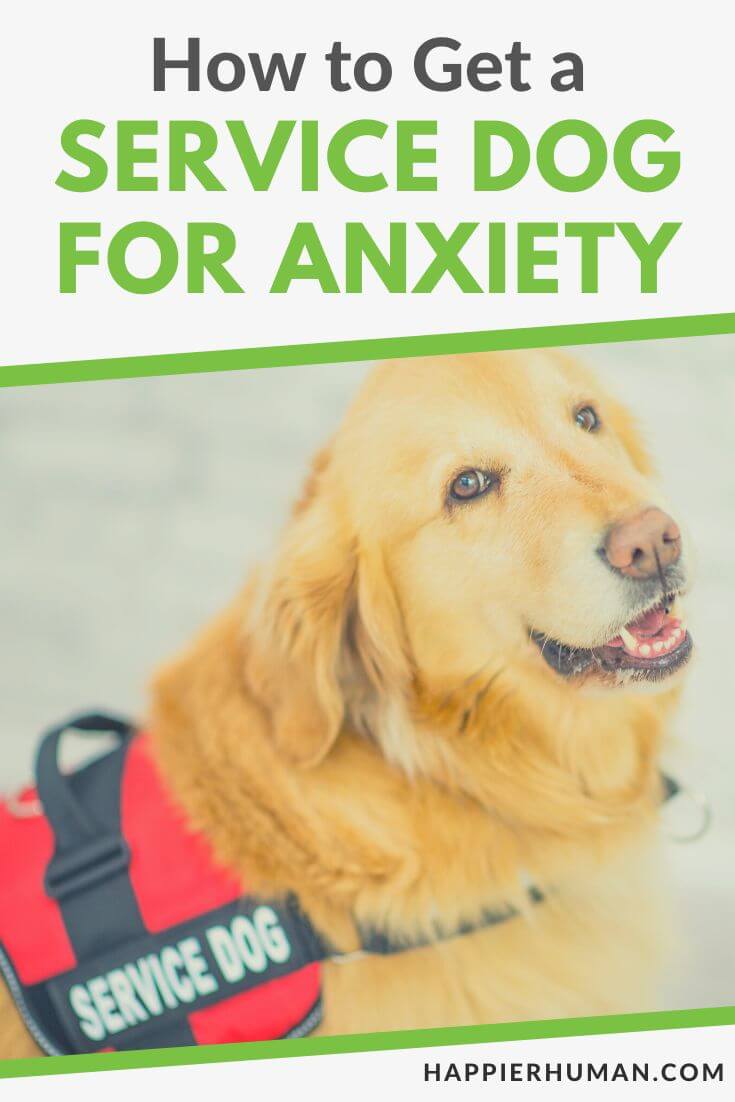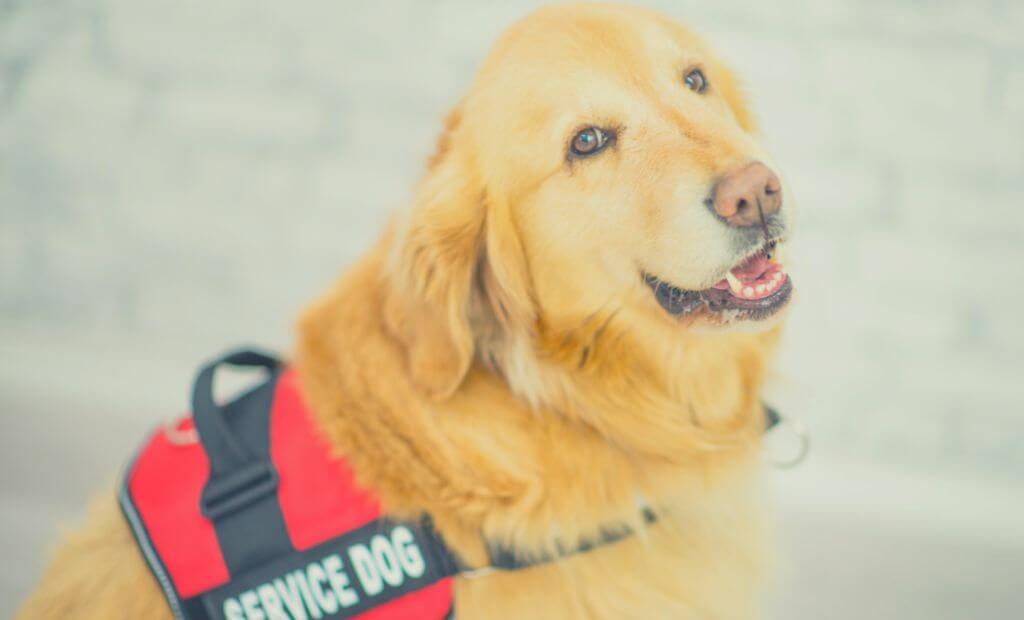There might be affiliate links on this page, which means we get a small commission of anything you buy. As an Amazon Associate we earn from qualifying purchases. Please do your own research before making any online purchase.
If you live with anxiety, you likely want to do whatever you can to relieve it. For example, maybe you’ve considered using a service dog for anxiety.
Dogs have long been used as service animals for people with disabilities. They can also serve those with mental health conditions like anxiety.
But what qualifies as a service dog, and how do you get a service dog? In this article, we’ll look at service dogs for anxiety and how you can get one.
What Is a Service Dog?
Many people find comfort and joy in having a faithful furry companion by their side. But service dogs are working dogs who go above and beyond to make their handlers’ lives easier.
According to the U.S. Department of Justice, a service dog has been “individually trained to do work or perform tasks for an individual with a disability.” A service dog’s goal is to make everyday life easier for people with certain conditions. So, service animals are typically dogs that are specially trained to assist people with disabilities or other medical needs.
The Americans with Disabilities Act legally requires businesses and organizations to modify their policies or procedures when necessary to accommodate people with disabilities. So because of the ADA, service dogs are allowed in public places or businesses that may not otherwise allow animals. Even most hospitals will allow service animals in the facility, where they would normally prohibit animals.
A dog is only considered a “service animal” when it's trained to do a special action for the owner. Service dogs may perform a wide variety of tasks, and they can play many important roles. For instance, service dogs may act as seeing eyes for people with blindness or pick things up for someone in a wheelchair.
They can even be trained to detect seizures in people with epilepsy. Dogs often have an uncanny ability to sense when something is wrong, like detecting a blood sugar that’s too high or low in someone with diabetes. Dogs can use their acute senses to anticipate problems and do something about them.
Difference Between a Service Dog and An Emotional Support Dog
Studies show that being around animals can reduce stress, lower blood pressure, and decrease loneliness. You may find that your dog improves your mood and gives you support just by being present. Pets can be a profound source of comfort and help us stay more calm and grounded.

But a pet is not considered a service animal unless trained to do a specific action. If they make you feel better just by being with you, they may be considered an emotional support animal or companion animal. But chances are you won’t be able to bring them with you anywhere in public as you would a service dog.
However, if your dog is trained to stop you from having an anxiety attack by performing a trained action, they likely qualify as a service dog.
Most Common Breeds of Service Dogs
Any breed of dog can be a service dog. There are no requirements regarding specific breeds. Yet, there are several dog breeds that are most commonly used as service dogs. Some breeds are better than others, because of temperament, behavior, and trainability.
Labrador and golden retrievers, collies, German shepherds, Saint Bernards, and cocker spaniels are some of the most popular service dog breeds.
Service dogs need to have several important characteristics. They have to be focused and obedient. They should want to please their handler. A service dog must be trained not to be distracted by whatever is going on around them — they need to be calm in a wide variety of environments.
Service dogs need to be able to socialize in different circumstances quickly. Since service dogs may go into many different public places, they need to remain calm, not reactive. Staying on task is vital for service dogs.
A service dog needs to be intelligent, trainable, and retain information easily. The dog’s size could also be important depending on what tasks they’ll perform. For instance, if a dog is going to reach medication on a counter or turn on lights, it will need to be big enough to do so.
Can a Service Dog Really Help With Anxiety, and How?
Pets are amazing sources of support for humans. No matter how old you are, interacting with a pet comes with surprising benefits. Research suggests pets can lower cortisol levels, decreasing stress and blood pressure. Being around animals can also help us practice mindfulness and bring comfort during illness.
Service dogs often assist people with physical disabilities. Seeing eye dogs assist the blind, and some dogs alert deaf people to things they can’t hear. Similarly, psychiatric service dogs provide support, but in different ways.
Psychiatric service dogs offer a comforting, therapeutic presence, but they also take action to help you through a crisis. Whether you’re living with anxiety, depression, PTSD, or another mental health condition, service dogs can be trained to help you through debilitating episodes.
For example, a service dog might bring you your anti-anxiety medication if you have a panic attack. Or, they may just remind you to take scheduled medications. A dog could be trained to lead a support person to you during a crisis or bring you the phone to call someone.
A service dog may keep people from coming too close to you if that’s a trigger. If you have anxiety or PTSD triggered by entering empty rooms, the dog may be trained to go in before you turn on a light. Or maybe they bring you a weighted blanket or a glass of water during an anxiety attack.
The dog can also be trained to sense when you’re about to have a panic attack and take whatever actions it’s trained in to help you.
For example, a dog could lay on your lap or chest to help you break through a crisis moment. Some people find their anxiety worse at night. A dog can be trained to lay at your feet or on your abdomen to provide tactile comfort and soothe anxiety.
As long as the dog is trained to do a certain thing that keeps you from harm or helps you get through your everyday life or crisis, they’re a service dog.
An added benefit of a service dog is it may help you get outside to walk or exercise, which is proven to boost happiness and energy.
How To Get a Service Dog for Anxiety
There are a few steps to getting a service dog for anxiety. First of all, you’ll need to have a stable home environment for the dog to live happily. You also need to have patience and good communication skills. You must be able to care for the dog long-term, financially, and otherwise.
To qualify for a service dog, you need to be diagnosed with a mental health condition that interferes with everyday life in some way. So the first step towards getting a service dog is talking to your doctor or a licensed therapist, who can provide you with a recommendation letter.
And remember, even if you don’t meet criteria for a service dog, you could still qualify for an emotional support or therapy dog. If you do qualify for a psychiatric service dog, the next step is to decide where to get one. There are a few different options.
Buy a Service Dog From a Professional Training Organization
One path is to get a professionally trained service dog from an organization. Your licensed therapist may be able to recommend organizations or programs that train service dogs. There are several places to get a service dog, such as Little Angels Service Dogs. Assistance Dogs International is one website where you can locate reputable service dog organizations.
However, it can cost $25,000 or more to purchase a professionally trained service dog. And there’s often a waiting list for one of these service dogs. But it can be worth the cost and wait, as the trainers have a lot of experience training dogs for specific needs and disabilities.

They may also spend time with you before and after getting your service dog to help you both transition and learn to work as a team.
The good news is that there are organizations that provide financial assistance or grants to help people get service dogs. NEADS World Class Service Dogs, Canine Companions for Independence, and American Humane Society are a few examples of organizations that might be able to help financially with getting a service dog.
Additionally, some organizations hold fundraisers and get support from the community to reduce the cost of service dogs. Your own family, church, or community organization could also help you fundraise for a professionally trained service dog.
If you’re a veteran, you could qualify to get a service dog through the VA. The Puppies Assisting Wounded Servicemembers for Veterans Therapy Act (PAWS Act) was signed in 2021 by President Biden to reduce the cost of therapy dogs for veterans with PTSD.
Train Your Own Service Dog
If a professionally trained service dog isn’t an option for you, you could also train a service dog yourself. Under the ADA, you don’t have to hire any kind of certified trainer to train your dog to be a service dog.
Therefore, you could get a dog from a breeder or from an animal shelter, or even train a dog you already have.
Just be aware that training your own dog can come with a steep learning curve. But it could be a good avenue if your dog has the right temperament and you have plenty of patience. An organization like the Certification Council for Professional Dog Trainers could also be a resource for finding a trainer to learn from.
Another option is to send your own dog to a training organization, where they can stay for a time and receive professional training.
Final Thoughts On How To Get a Service Dog
If you suffer from anxiety or another mental health condition, you may benefit from a psychiatric service dog. A dog could help reduce stress and fear and improve your quality of life.
In addition to a service dog, there are ways to reduce anxiety, such as using daily affirmations or anxiety quotes to reduce stress. You could try a mental health app to track your mood, practice mindfulness, or even talk to a therapist.
Psychotherapy, medication, yoga and meditation, and a healthy diet can all help reduce anxiety symptoms so you can live a fulfilling life. Service dogs are just one of many wonderful resources to help you do just that.
Finally, if you want a simple way to reduce your stress and anxiety, then try writing these 35 mindfulness journaling prompts to live more in the present moment.


